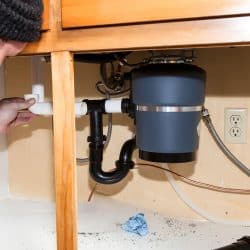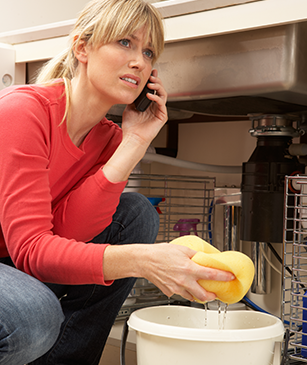Quick Steps to Stop a Leak in Your Garbage Disposal
Quick Steps to Stop a Leak in Your Garbage Disposal
Blog Article
Do you find yourself in search of information and facts concerning How to fix a pretty consistent leak from my garbage disposal?

Garbage disposals are vital kitchen area devices that aid in dealing with food waste successfully. Nevertheless, a dripping waste disposal unit can be an aggravating and messy problem to take care of. Fortunately, many leakages can be taken care of easily with a couple of basic steps. In this post, we will discuss exactly how to fix a dripping garbage disposal properly.
Introduction
Waste disposal unit are installed under kitchen area sinks and are made to shred food waste right into smaller pieces, permitting it to pass through the plumbing system quickly. While these tools are generally trustworthy, leakages can happen gradually as a result of wear and tear, loose connections, or damage to the unit.
Step-by-Step Guide to Repairing a Leaking Garbage Disposal
Switch off the Power
Before trying any repairs, guarantee that the power to the garbage disposal system is shut off to stop the danger of electric shock.
Locate the Leakage
Recognize the specific location of the leakage and identify the reason
Tighten Connections
Make use of a wrench to tighten any kind of loosened links between the disposal system and the pipes system.
Replace Seals or Gaskets
If the leak results from worn seals or gaskets, remove the old components and replace them with new ones.
Patching Cracks or Openings
For fractures or openings in the disposal unit, use epoxy or an ideal patching material to secure the broken area.
Determining the Source of the Leakage
Before attempting to fix a leaking waste disposal unit, it is necessary to identify the source of the leakage. This can generally be done with aesthetic examination or by conducting easy examinations.
Visual Assessment
Evaluate the garbage disposal system carefully for any signs of water leak. Pay close attention to locations around seals, gaskets, and link factors.
Checking for Leaks
One way to evaluate for leaks is by running water via the disposal device and looking for any type of visible indicators of leak.
Common Causes of Leakages in Rubbish Disposals
Worn Seals and Gaskets
Seals and gaskets play a crucial duty in avoiding water from leaking out of the waste disposal unit. Over time, these parts can weaken, causing leakages around the disposal unit.
Loose Connections
The links between the garbage disposal and the pipes system can come to be loosened over time, triggering water to leak out throughout procedure.
Splits or Holes in the Disposal Unit
Physical damage to the garbage disposal, such as cracks or holes in the housing, can additionally lead to leaks.
Devices and Products Needed for Repairing a Leaking Waste Disposal Unit
Prior to starting the fixing procedure, gather the needed devices and materials, including a screwdriver, flexible wrench, plumbing technician's putty, substitute seals or gaskets, and epoxy or patching material for fixing fractures or holes.
Testing the Waste Disposal Unit After Fixing
When the repair is full, check the garbage disposal by running water via it to guarantee that the leakage has actually been fixed.
Preventive Upkeep Tips to Prevent Future Leaks
To prevent future leakages, it is essential to execute regular upkeep on your waste disposal unit. This consists of keeping it tidy, avoiding placing non-food items or difficult things down the disposal, and periodically looking for leakages or other problems.
Final thought
Finally, taking care of a dripping garbage disposal is a fairly uncomplicated procedure that can be completed with basic tools and products. By complying with the actions laid out in this article and practicing preventive maintenance, you can keep your garbage disposal in good working condition and avoid costly repair work in the future.
HERE’S HOW TO FIX YOUR GARBAGE DISPOSAL
WHAT TO DO IF SOMETHING IS STUCK IN YOUR GARBAGE DISPOSAL
If the impeller won’t turn, there’s probably something stuck in the disposal. It could be a steak bone or peach pit, although plumbers report pulling all sorts of inappropriate objects out of disposals, such as bottle caps or aluminum foil. Make sure power to the disposal is off, and look inside to see if you can see the source of the jam.
Never stick your fingers in a disposal. Pull out anything you see with tongs or pliers.
If the disposal still won’t work, it may be time to call a plumber or consider buying a new disposal. GEM Plumbing & Heating is here for all of your garbage disposal needs.
WHAT TO DO IF YOUR GARBAGE DISPOSAL DRAIN IS CLOGGED
Take everything out from underneath your sink and put a bucket or other container under your disposal to catch any water that drains out. Disconnect your disposal from the power supply. If it’s plugged into a wall outlet, unplug it. If it’s hardwired into an electrical box, go to the electrical panel and turn off the breaker for the disposal. Pour ¼ cup of baking soda into the drain, followed by ½ cup of white vinegar. Give the solution a few minutes to fizz and do its work. Look into the disposal with a flashlight to see if you can see an object that might be causing the clog. If you see it, remove it using tongs or pliers. MORE TIPS ON DEALING WITH A CLOGGED GARBAGE DISPOSAL
Never use drain cleaner in a garbage disposal. It can damage the plastic parts inside the disposal. You can also be splashed with the caustic liquid while working to clear the clog. Beware! Never stick your fingers into a garbage disposal. Trust us — not a good idea. In many instances, your dishwasher drains through your garbage disposal. This allows the disposal to grind any large food particles that may be drained out of your dishwasher. There are some jurisdictions, however, where the plumbing code prohibits such a connection. WHAT TO DO WHEN YOUR DISHWASHER DRAINS THROUGH THE DISPOSAL
Run some water in the sink so your plunger has at least a ½-inch of water to create a seal and plunge vigorously up and down several times. You may need to repeat this several times. Run hot water down the drain to clear any residue that remains.

As a reader on Why Is , I thought sharing that excerpt was a smart idea. Appreciated our write-up? Please share it. Help somebody else check it out. Bless you for your time. Visit us again soon.
Appointment Report this page